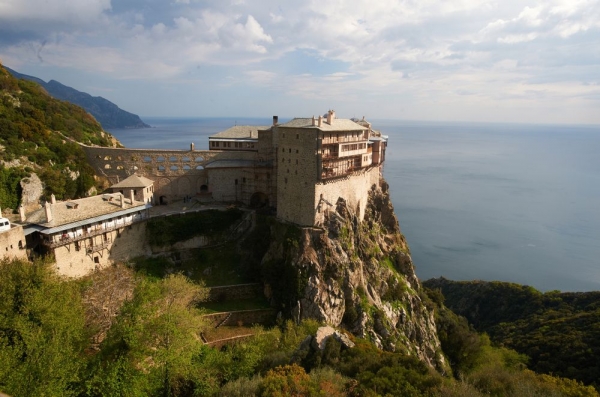Mount Athos || Halkidiki
Friday, 01 September 2017 21:56This peninsula of 390 km² houses over 1,700 monks in 20 Eastern Orthodox monasteries and their associated sketae (cloisters) and cells. An autonomous state under Greek sovereignty, entry into the area is strictly controlled and only male residents are allowed to live there and only male visitors allowed.
Agio Oros (Holy Mountain) is a self-governed part of the Greek state, politically subject to the Ministry of Foreign Affairs and to the Ecumenical Patriarchate of Constantinople as regards its religious aspect. The mountain is dedicated to the Holy Mother of God, and by an imperial document (typicon) the avaton was established and no female may set foot on the peninsula. Most of its inhabitants are Orthodox monks living in monasteries, sketai (collections of small cells with a central chapel), cells and hermitages. Those who are not members of the clergy include employees and workers. There are also numerous male pilgrims (up to 110 can enter per day) to Agio Oros, who come for the purposes of meditation, prayer and study.
Of the twenty monasteries, one is Russian, one is Bulgarian, one is Serbian, one is Georgian and the rest are Greek. There are also Romanian and Bulgarian sketai. Foreign monasteries and sketae are supported by their respective countries.
These monasteries possess holy relics, icons, frescoes and mosaics of great value. Although many have been lost in fires or stolen during raids, a vast array of historical texts, rare documents and manuscripts - all historical heirlooms - are kept in their libraries.
The first to settle here were iconodules, members of the clergy fleeing from the persecution of the iconoclasts. They came and lived as anchorites, unknown, and literally alone inside caves. Later, monasteries were built and were organised in a monastic state. Agio Oros became a refuge for those seeking to save their souls through fasting and praying, and its prestige grew so greatly that even Byzantine emperors might spend time as monks here.
The right of autonomy of Agio Oros was granted gradually, initially by the Byzantine emperors Nikiforos Fokas and Ioannis Tsimiskis. This autonomy was maintained and even enhanced throughout the period of Ottoman rule up to this day. After WWI, a series of international treaties recognized the special status of the mountain. Although nominally part of Greece, special stipulations and exemptions apply in regard to Greece's accession to the European Community (now European Union).
Average visitors can stay for free at each monastery for one day, for a maximum of three nights/four days, pending acceptation of a request and only after having secured a written permission (diamonitirion) from a dedicated bureau in Thessaloniki. Scholars and genuine Orthodox novices can obtain longer permissions.
The monasteries, which in Mount Athos amount to twenty:
Great Lavra (Μεγίστη Λαύρα Megísti Lávra): the oldest monastery in the Holy Mountain.
Vatopédi (Βατοπέδι): the second oldest monastery.
Iviron (Ιβήρων): an ancient Georgian monastery, now populated by Greek monks.
Chilandariou (Χιλανδαρίου, or Хиландар Hilandar in Serbian): a Serbian monastery, populated by Serbian monks.
Dionysiou (Διονυσίου)
Koutloumousiou (Κουτλουμούσι)
Pantokratoros (Παντοκράτορος)
Xiropotamou (Ξηροποτάμου)
Zographou (Ζωγράφου, Зограф Zograf in Bulgarian): a Bulgarian monastery, populated by Bulgarian monks.
Dochiariou (Δοχειάριου)
Karakalou (Καρακάλλου)
Philotheou (Φιλοθέου)
Simonos Petra (Σίμωνος Πέτρα or Σιμωνόπετρα): a Greek monastery, very cosmopolitan in its composition, including monks from many places over the world.
Agiou Pavlou (Αγίου Παύλου)
Stavronikita (Σταυρονικήτα)
Xenofondos (Ξενοφώντος): a Greek monastery which has one of the biggest katholikon (church) in the Holy Mountain.
Osiou Grigoriou (Οσίου Γρηγορίου)
Agiou Panteleimonos (Αγίου Παντελεήμονος, or Ρωσικό Rossikon): the Russian monastery, populated by Russian monks.
Konstamonitou (Κωνσταμονίτου)
The eighteenth monastery in rank - Esphigmenou (Εσφιγμένου) - is currently populated by monks under a schism dispute with the Patriarchate of Constantinople, and may not be open or suitable for visitors.
source wikitravel.org
